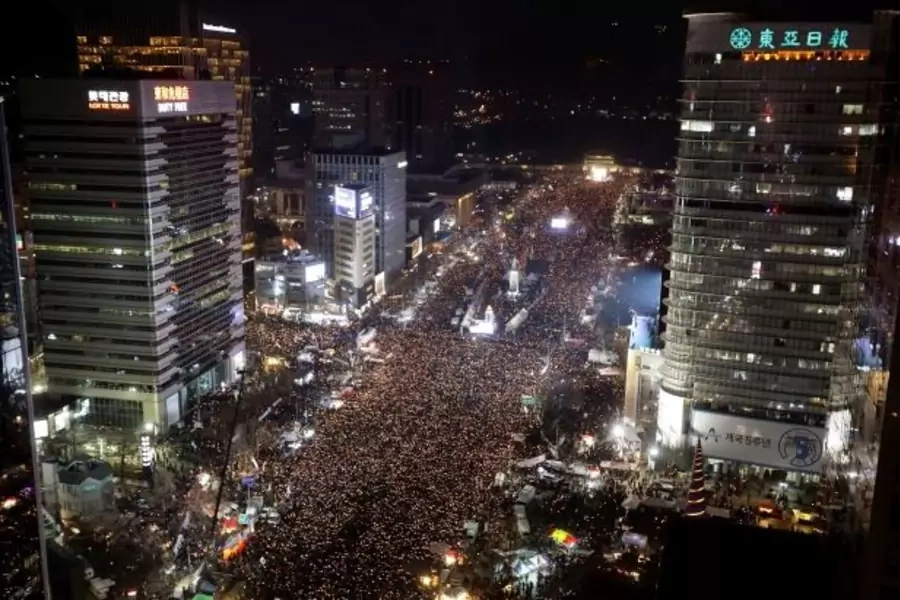More on:
This post was coauthored with Sungtae (Jacky) Park, research associate at the Council on Foreign Relations.
South Korea is in turmoil, with President Park Geun-hye having been suspended from office by the South Korean national assembly after being implicated as an accomplice in the criminal investigation of her close friend, Choi Soon-sil. Consequently, the South Korean conservatives have lost popularity among the public, and the center-left Minjoo Party’s Moon Jae-in has emerged as the front-runner in South Korea’s looming presidential election, which must be held within sixty days if Park’s impeachment is upheld at the South Korean constitutional court.
This situation has led many Korea-watchers to be concerned about how Seoul might reorient its foreign policy, with the South Korean progressives poised to retake the Blue House. Unlike the conservatives, the progressives tend to be more skeptical of the planned deployment of the Terminal High-Altitude Area Defense (THAAD) system on the Korean Peninsula, critical of the December 2015 comfort woman agreement with Japan, and have indicated desires to reengage in diplomacy with North Korea.
But sometimes it is more useful to step back and examine the forest, rather than focusing on the trees. A careful evaluation of South Korea’s national interests, constraints, variables affecting its foreign policy, and strategic options, in a recent Council on Foreign Relations discussion paper, The Korean Pivot: Seoul’s Strategic Choices and Rising Rivalries in Northeast Asia, authored by Scott Snyder, Darcie Draudt, and Sungtae (Jacky) Park, reveals that South Korea’s future choices are constrained by many broader structural forces outside of Seoul’s control.
To begin with, South Korea is dealing with an increasingly precarious regional environment. The reliability of the U.S.-Korea alliance has been thrown into question. Moreover, North Korea’s nuclear and missile development continues, and the country may be capable of mounting a nuclear warhead on its medium-range Nodong missiles to threaten Japan and South Korea. South Korea also faces the risk of being caught in conflicts involving the United States, China, and Japan, while South Korea’s trade-dependent economy means the country’s economic prospects rely on international market forces, limiting its own ability to manage economic affairs. These external variables will matter more in shaping Seoul’s strategic choices than policy positions taken by a newly-elected South Korean president, who must navigate these treacherous issues with limited margin for error.
Given that Northeast Asia’s security environment is deteriorating, Seoul will no doubt continue to seek a strong alliance with Washington and is unlikely to pursue a foreign policy of neutrality, independence, or alignment with China. At the same time, South Korea will likely pursue a combination of hedging, regionalism, and networking to mitigate regional tensions and to avoid entrapment in great power conflicts, although Seoul could choose to balance against China at a later stage. Effective hedging would require South Korea to not only pursue friendly relations with China, but also make a clear assessment of issues critical to the maintenance of the U.S.-ROK alliance, those that affect U.S.-ROK relations but may not be critical, and decisions that can be deferred. Moreover, South Korea needs to pursue serious economic reforms to maintain its status as a middle power and improve relations with Japan.
For its part, Washington should avoid overreacting to every South Korean move that seems to be “tilting toward Beijing”; South Korea is not about to become a Chinese tributary state. Moreover, a loosening of the alliance would undercut Seoul’s leverage with Beijing and is not in South Korea’s interest. South Korea is also unlikely to unilaterally call for the removal of U.S. troops on the Korean Peninsula under current conditions. The United States should recognize that a positive Sino-South Korean relationship, if it can be achieved, will contribute to stability in Northeast Asia by mitigating Chinese concerns that the U.S.-ROK alliance might be directed against China.
South Korea ultimately shares with the United States an interest in the freedom of navigation and in maintaining the liberal world order. Given that the Korean Peninsula is geographically closer to China than to the United States or Japan, South Korea would be the first to suffer if the Chinese modify the regional order in their favor. In such a case, South Korea would naturally increase U.S.-Japan-ROK trilateral security cooperation and take a tougher stance against Chinese revisionism. Until then, Washington can afford to be patient.
The United States should also support South Korea’s attempts at network diplomacy and the creation of regional security mechanisms. Seoul’s pursuit of such initiatives will not fundamentally alter the overall regional dynamics, but such initiatives could be tension-mitigating mechanisms that help to delay and manage crises. As a country sensitive to both U.S. and Chinese interests, South Korea could be in a good position to push regional mechanisms and network diplomacy with U.S. backing. Washington has yet to enthusiastically endorse Seoul’s initiatives such as the erstwhile Northeast Asia Peace and Cooperation Initiative (NAPCI), but Northeast Asian stability could benefit from better U.S.-ROK coordination on regionalism and networking.
Despite the rising uncertainty that South Korea has to deal with, in the face of both its own domestic political crisis and the election of Donald Trump, the North Korean threat is becoming ever more dangerous and is a common challenge for both the United States and South Korea. Both countries also have to deal with an increasingly complex regional environment in Northeast Asia. Given the costs and stakes involved, no American president can afford to step away from the Korean Peninsula, and South Korea’s next president will inherit the same problems and constraints that the Park administration has faced in its efforts to solve what she termed the “Asian Paradox.”
For more information on the themes discussed above, please download the CFR discussion paper, The Korean Pivot: Seoul’s Strategic Choices and Rising Rivalries in Northeast Asia.
More on:
 Online Store
Online Store
